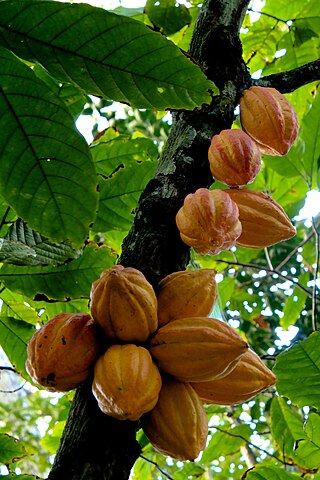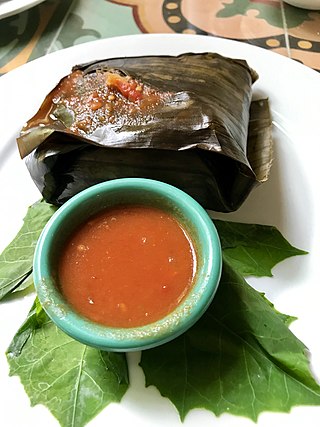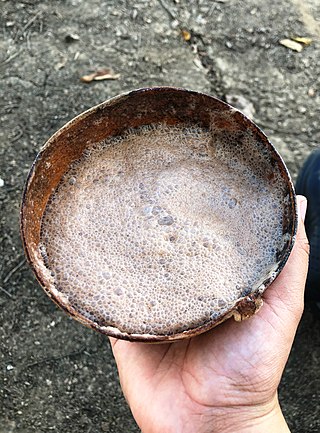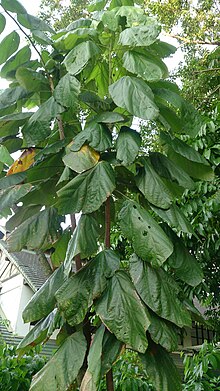
The cocoa bean or simply cocoa, also called cacao, is the dried and fully fermented seed of Theobroma cacao, the cacao tree, from which cocoa solids and cocoa butter can be extracted. Cocoa trees are native to the Amazon rainforest. They are the basis of chocolate and Mesoamerican foods including tejate, an indigenous Mexican drink.

Theobroma cacao is a small evergreen tree in the family Malvaceae. Its seeds, cocoa beans, are used to make chocolate liquor, cocoa solids, cocoa butter and chocolate. Native to the tropics of the Americas, the largest producer of cocoa beans in 2018 was Ivory Coast, at 2.2 million tons. Its leaves are alternate, entire, unlobed, 10–50 cm (4–20 in) long and 5–10 cm (2–4 in) broad.

Agriculture in Mesoamerica dates to the Archaic period of Mesoamerican chronology. At the beginning of the Archaic period, the Early Hunters of the late Pleistocene era led nomadic lifestyles, relying on hunting and gathering for sustenance. However, the nomadic lifestyle that dominated the late Pleistocene and the early Archaic slowly transitioned into a more sedentary lifestyle as the hunter gatherer micro-bands in the region began to cultivate wild plants. The cultivation of these plants provided security to the Mesoamericans, allowing them to increase surplus of "starvation foods" near seasonal camps; this surplus could be utilized when hunting was bad, during times of drought, and when resources were low. The cultivation of plants could have been started purposefully, or by accident. The former could have been done by bringing a wild plant closer to a camp site, or to a frequented area, so it was easier access and collect. The latter could have happened as certain plant seeds were eaten and not fully digested, causing these plants to grow wherever human habitation would take them.

Theobroma grandiflorum, commonly known as cupuaçu, also spelled cupuassu, cupuazú, cupu assu, or copoazu, is a tropical rainforest tree related to cacao. Native and common throughout the Amazon basin, it is naturally cultivated in the jungles of north of Brazil, with the largest production in Pará, Amazonas and Amapá, Colombia, Bolivia and Peru. The pulp of the cupuaçu fruit is consumed throughout Central and South America, especially in the northern states of Brazil, and is used to make ice creams, snack bars, and other products.

Theobroma is a genus of flowering plants in the mallow family, Malvaceae, that is sometimes classified as a member of Sterculiaceae. It contains roughly 20 species of small understory trees native to the tropical forests of Central and South America.

Bactris gasipaes is a species of palm native to the tropical forests of Central and South America. It is well spread in these regions, where it is often cultivated by smallholders in agroforestry systems or more rarely, in monoculture. Common names include peach palm in English, among others used in South American countries. It is a long-lived perennial plant that is productive for 50 to 75 years on average. Its population has an important genetic diversity, leading to numerous fruits, colors, and qualities. The fruits are edible and nutritious but need to be cooked for 30 minutes to five hours. They also benefit many animals in the wild. Peach-palms are also cultivated for the heart of palm, and the trunk can make valuable timber.

Cauliflory is a botanical term referring to plants that flower and fruit from their main stems or woody trunks, rather than from new growth and shoots. It is rare in temperate regions but common in tropical forests.

Irvingia gabonensis is a species of African trees in the genus Irvingia, sometimes known by the common names wild mango, African mango, or bush mango. They bear edible mango-like fruits, and are especially valued for their fat- and protein-rich nuts.

Brosimum alicastrum, commonly known as breadnut, Maya nut or ramon, and many others, is a tree species in the family Moraceae of flowering plants, whose other genera include figs and mulberries. The plant is known by a range of names in indigenous Mesoamerican and other languages, including: ojoche, ojite, ojushte, ujushte, ujuxte, capomo, mojo, ox, iximche, masica in Honduras, uje in the state of Michoacan Mexico, mojote in Jalisco, chokogou in Haitian Creole and chataigne in Trinidadian Creole. In the Caribbean coast of Colombia it is called guaímaro or guaymaro.

Ancient Maya cuisine was varied and extensive. Many different types of resources were consumed, including maritime, flora, and faunal material, and food was obtained or produced through strategies such as hunting, foraging, and large-scale agricultural production. Plant domestication concentrated upon several core foods, the most important of which was maize.

Tejate is a non-alcoholic maize and cacao beverage traditionally made in Oaxaca, Mexico, originating from pre-Hispanic times. It remains very popular among the indigenous Mixtec and Zapotec peoples, especially in rural areas. It is also very popular in Oaxaca and the surrounding regions. Principal ingredients include toasted maize, fermented cacao beans, toasted mamey pits (pixtle) and flor de cacao. These are finely ground into a paste. The paste is mixed with water, usually by hand, and when it is ready, the flor de cacao rises to the top to form a pasty foam. It can be served as-is or with some sugar syrup to sweeten it. The drink is served cold.

Moniliophthora perniciosa is a fungus that causes "witches' broom disease" (WBD) of the cocoa tree T. cacao. This pathogen is currently limited to South America, Panama and the Caribbean, and is perhaps one of the best-known cocoa diseases, thought to have co-evolved with cocoa in its centre of origin.

Moniliophthora roreri is a basidiomycete fungus that causes frosty pod rot disease, one of the most serious problems for cacao production in Latin America. This disease and together with witches’ broom disease and black pod rot constitute the cacao disease trilogy. It causes serious losses in southwestern parts of South America; spores are dry and powdery and are spread easily by water movement, wind, or movement of pods; disease spread is highest during periods of high rainfall.

Cola nitida is a species of plant belonging to the family Malvaceae.

Hypomeces pulviger, also known as the gold-dust weevil or green weevil, is a species of beetle in the true weevil family. The adult weevil can reach a length of about 14 mm (0.6 in) and is covered with iridescent green or yellowish-green dust-like scales all over the body. This species can be found in India, tropical Southeast Asia, and the Philippines. Both the larvae and adults are crop pests. The larvae live in and pupate in the soil, feeding on living plant roots. The adult weevils are long-lived, doing damage to foliage, and sometimes defoliating young bushes and nursery trees.

Theobroma speciosum is an arboriform species of flowering plant in the mallow family native to northern South America. It is the 35th most abundant species of tree in the Amazon rainforest.
Mesoamerican cuisine – has four main staples: maize, beans, squash and chili. Other plant-based foods used include: amaranth, avocado, cassava, cherimoya, chia, chocolate, guava, nanche, pineapple, sapodilla, sweet potatoes, yucca and zapote.

Popo is a foamy and cold drink typical in the south of the state of Veracruz and some areas of the state of Oaxaca, like the basin of Papaloapan or Istmo. Its main ingredient is cocoa, which is sweetened with sugar or panela, and is mixed with water; also azquiote called cocomeca en Oaxaca is added, and/or chupipi, both foaming agents. Some recipes frequently flavor it with cinnamon and/or anise, and they thicken it with maize dough or rice.




















